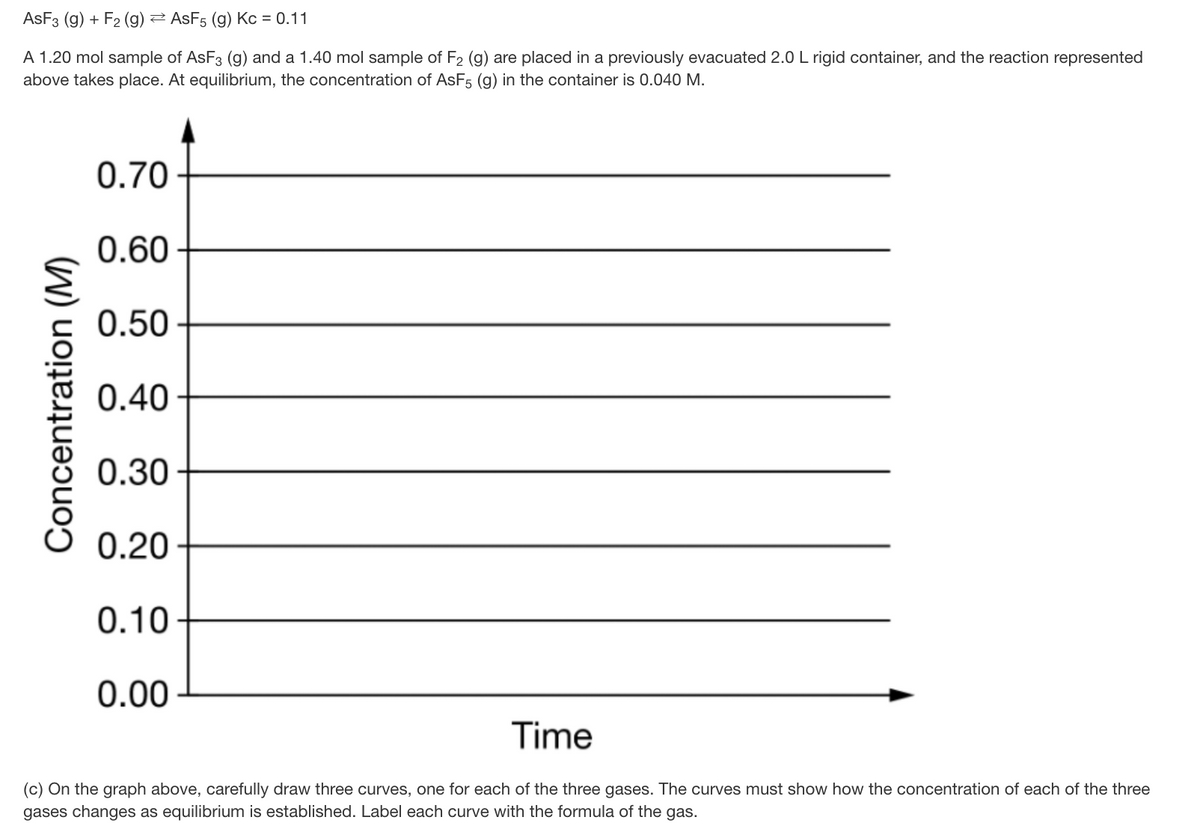ASF3 (g) + F2 (g) 2 AsF5 (g) Kc = 0.11 A 1.20 mol sample of AsF3 (g) and a 1.40 mol sample of F2 (g) are placed in a previously evacuated 2.0 L rigid container, and the reaction represented above takes place. At equilibrium, the concentration of AsF5 (g) in the container is 0.040 M.
ASF3 (g) + F2 (g) 2 AsF5 (g) Kc = 0.11 A 1.20 mol sample of AsF3 (g) and a 1.40 mol sample of F2 (g) are placed in a previously evacuated 2.0 L rigid container, and the reaction represented above takes place. At equilibrium, the concentration of AsF5 (g) in the container is 0.040 M.
Chemistry for Engineering Students
4th Edition
ISBN:9781337398909
Author:Lawrence S. Brown, Tom Holme
Publisher:Lawrence S. Brown, Tom Holme
Chapter12: Chemical Equilibrium
Section: Chapter Questions
Problem 12.34PAE: 1’he reaction in Exercise 12.33 was repeated. This time, the reaction began when only NO was...
Related questions
Question

Transcribed Image Text:ASF3 (g) + F2 (g) 2 AsF5 (g) Kc = 0.11
A 1.20 mol sample of ASF3 (g) and a 1.40 mol sample of F2 (g) are placed in a previously evacuated 2.0L rigid container, and the reaction represented
above takes place. At equilibrium, the concentration of ASF5 (g) in the container is 0.040 M.
0.70
0.60
0.50
0.40
0.30
0.20
0.10
0.00
Time
(c) On the graph above, carefully draw three curves, one for each of the three gases. The curves must show how the concentration of each of the three
gases changes as equilibrium is established. Label each curve with the formula of the gas.
Concentration (M)
Expert Solution
This question has been solved!
Explore an expertly crafted, step-by-step solution for a thorough understanding of key concepts.
This is a popular solution!
Trending now
This is a popular solution!
Step by step
Solved in 3 steps with 1 images

Knowledge Booster
Learn more about
Need a deep-dive on the concept behind this application? Look no further. Learn more about this topic, chemistry and related others by exploring similar questions and additional content below.Recommended textbooks for you

Chemistry for Engineering Students
Chemistry
ISBN:
9781337398909
Author:
Lawrence S. Brown, Tom Holme
Publisher:
Cengage Learning

Chemistry: Principles and Practice
Chemistry
ISBN:
9780534420123
Author:
Daniel L. Reger, Scott R. Goode, David W. Ball, Edward Mercer
Publisher:
Cengage Learning

Chemistry: An Atoms First Approach
Chemistry
ISBN:
9781305079243
Author:
Steven S. Zumdahl, Susan A. Zumdahl
Publisher:
Cengage Learning

Chemistry for Engineering Students
Chemistry
ISBN:
9781337398909
Author:
Lawrence S. Brown, Tom Holme
Publisher:
Cengage Learning

Chemistry: Principles and Practice
Chemistry
ISBN:
9780534420123
Author:
Daniel L. Reger, Scott R. Goode, David W. Ball, Edward Mercer
Publisher:
Cengage Learning

Chemistry: An Atoms First Approach
Chemistry
ISBN:
9781305079243
Author:
Steven S. Zumdahl, Susan A. Zumdahl
Publisher:
Cengage Learning

Chemistry & Chemical Reactivity
Chemistry
ISBN:
9781133949640
Author:
John C. Kotz, Paul M. Treichel, John Townsend, David Treichel
Publisher:
Cengage Learning

Chemistry & Chemical Reactivity
Chemistry
ISBN:
9781337399074
Author:
John C. Kotz, Paul M. Treichel, John Townsend, David Treichel
Publisher:
Cengage Learning

Chemistry: The Molecular Science
Chemistry
ISBN:
9781285199047
Author:
John W. Moore, Conrad L. Stanitski
Publisher:
Cengage Learning